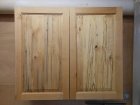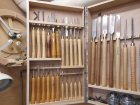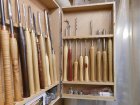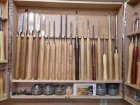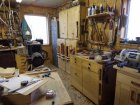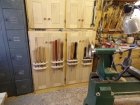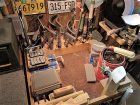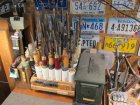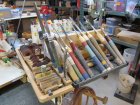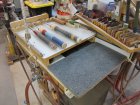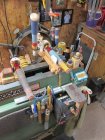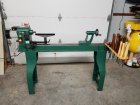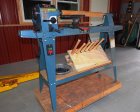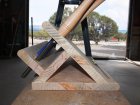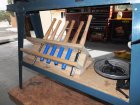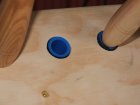-
November 2025 Turning Challenge: Wall Hanging! (click here for details) -
Sign up for the 2025 AAW Forum Holiday Swap by Monday, November 24th (click here for details) -
Congratulations to Konstantin Gusev for "The Nutcracker" being selected as Turning of the Week for November 17, 2025 (click here for details) -
Welcome new registering member. Your username must be your real First and Last name (for example: John Doe). "Screen names" and "handles" are not allowed and your registration will be deleted if you don't use your real name. Also, do not use all caps nor all lower case.
You are using an out of date browser. It may not display this or other websites correctly.
You should upgrade or use an alternative browser.
You should upgrade or use an alternative browser.
Show us your tool rack/cart
- Thread starter Douglas Ladendorf
- Start date
That's really nice. I've been thinking about making something like that.View attachment 27005 View attachment 27006 View attachment 27004 View attachment 27003 View attachment 27007 This is my lathe tool cabinet.
Are the door panels spalted maple?
Panels are spalted Birch, rails and stiles are alder. Cabinet box was made from 5/8” 13 ply mahogany faced marine plywood. All my shop walls, ceiling and cabinets were done in this plywood.
Odie
Panning for Montana gold, with Betsy, the mule!
My tool rack. Doors opened and closed. The white panels are dry erase boards. View attachment 26996 View attachment 26997
Must be great for taking notes! Good idea, Donna......
-----odie-----
Odie
Panning for Montana gold, with Betsy, the mule!
Martin Groneng
Dances the Gouge Jig
Pretty clean looking shop, odie and you claim to be a busy woodturner??? The place looks like it hasn't been "in use" since before the last licence plate posting on the wall!! HA! HA!
Odie
Panning for Montana gold, with Betsy, the mule!
Pretty clean looking shop, odie and you claim to be a busy woodturner??? The place looks like it hasn't been "in use" since before the last licence plate posting on the wall!! HA! HA!
- Joined
- Jan 27, 2005
- Messages
- 13,174
- Likes
- 5,747
- Location
- Dalworthington Gardens, TX
- Website
- pbase.com
I'm not sure that Odie does any turning. I think that he just makes shop jigs.  And collects license plates.
And collects license plates. 
Now Odie that is what I call organized!!I love seeing other turner's shops, especially those that look well used.....
I took these photos yesterday.......the shop is always a "work in progress", so I thought I'd update.
View attachment 27015 View attachment 27016 View attachment 27017 View attachment 27018 View attachment 27019
-----odie-----
Martin Groneng
Dances the Gouge Jig
Organised???? Just ask the Lady of the house!! If he was organised, he would make enough wood turning money to take the plates off our Model T Ford and put them on the wall and buy US a new set of wheels! Something big enough to collect............... More Wood!!!
Odie
Panning for Montana gold, with Betsy, the mule!
(We really really need a laughing emotee!I'm not sure that Odie does any turning. I think that he just makes shop jigs.And collects license plates.

Now Odie that is what I call organized!!
You know, Lamar......there has been a million times I've told myself "now, I've got everything just the way I want it"......only to change things around......again, and again!
I think some people have a natural instinct to resist modifying tools and tooling. Admittedly, sometimes I screw things up that way.......but, the successes are absolutely worth the aggravation of the occasional SNAFU!.......
-----odie-----
- Joined
- Feb 6, 2010
- Messages
- 3,421
- Likes
- 2,503
- Location
- Brandon, MS
- Website
- threeringswoodshop.square.site
meeee tooooooo You do not learn if u do not try(We really really need a laughing emotee!)
You know, Lamar......there has been a million times I've told myself "now, I've got everything just the way I want it"......only to change things around......again, and again!
I think some people have a natural instinct to resist modifying tools and tooling. Admittedly, sometimes I screw things up that way.......but, the successes are absolutely worth the aggravation of the occasional SNAFU!.......
-----odie-----
I have done it "that way", and its not as much fan as trying a "different way" so do it the different way, you will learn something new. Even if it doesn't work you will learn.
It's more fun that way.
Stu
It's more fun that way.
Stu
Nice lathe Bobby, like your handy tool holder, good idea.
Bobby,
With that model of lathe you can cut a piece of plywood and position between the lathe legs which can provide a platform to lay sandbags which will be needed when turning larger pieces or you can bolt the lathe to the floor.
With that model of lathe you can cut a piece of plywood and position between the lathe legs which can provide a platform to lay sandbags which will be needed when turning larger pieces or you can bolt the lathe to the floor.
Thanks for the idea Mike!. It's not in this picture, but I made a toolbox later to hold my chucks, etc.... It sits on the second shelf and goes from one end to the other. That puts a bit more weight on the lathe right now. With what I'm doing on it, I don't get any movement or vibration yet. If/when I get good enough to advance to large items, I will probably looking at ways to secure the lathe better. Thanks again!Bobby,
With that model of lathe you can cut a piece of plywood and position between the lathe legs which can provide a platform to lay sandbags which will be needed when turning larger pieces or you can bolt the lathe to the floor.
I have no idea how do you guys keep your shop clean. Mine has chips in every corner and every drawer.
I'm kinda OCD. Lol I always cleanup after I turn and before I finish. Then vacuum and sweep shop after project is done.I have no idea how do you guys keep your shop clean. Mine has chips in every corner and every drawer.
Be careful using that articulating toolrest, it is kind of flimsy for large turning. My first lathe was that breed.
I'm kinda OCD. Lol I always cleanup after I turn and before I finish. Then vacuum and sweep shop after project is done.
I need to spend a day deep cleaning and re-arranging my shop. I should get a shop vac too... maybe next summer, I’m busy (lazy) to do it in the winter
A shop vac is a good way to gather up all that sawdust. Good for the flower beds and stuff. LolI need to spend a day deep cleaning and re-arranging my shop. I should get a shop vac too... maybe next summer, I’m busy (lazy) to do it in the winter
Was just revisiting this and discovered that since I'd posted what I was using, a serious upgrade has occurred.
On one of our shopping trips to Sam's I saw a nice table with drawers that would make a good base for what I wanted. So, with some bracket, spring clamps, and magnetic bars--it happened! (Didn't realize I'd accumulated so many tools--please don't tell the Mrs.)
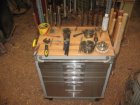
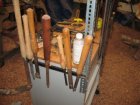
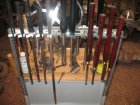
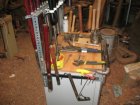
On one of our shopping trips to Sam's I saw a nice table with drawers that would make a good base for what I wanted. So, with some bracket, spring clamps, and magnetic bars--it happened! (Didn't realize I'd accumulated so many tools--please don't tell the Mrs.)




Odie
Panning for Montana gold, with Betsy, the mule!
Got this from a friend who picked it up at a garage sale. Works great for me with two lathes, can work from both sides.
View attachment 27097 View attachment 27098 View attachment 27097
Love that articulating table......that must be really handy!
-----odie-----
Odie
Panning for Montana gold, with Betsy, the mule!
@Bobby Smith .....I'll bet half the people who posted in this thread, have made changes to their tool racks since posting here. It's just the way things are, if we intend to keep our shops up-to-date with the times. "Retrofit" is a word that should be a part of a turner's vocabulary......that is.....If he believes in the concept of "improving thyself".....! 
When I ditched my old Woodfast banjo, and replaced it with a Robust banjo (a very important upgrade, IMHO), that required a re-do of the special tools I keep handy on, and near my bedway tool shelf. Life goes on, and we MUST adapt to a new, and changing shop environment!
-----odie-----
When I ditched my old Woodfast banjo, and replaced it with a Robust banjo (a very important upgrade, IMHO), that required a re-do of the special tools I keep handy on, and near my bedway tool shelf. Life goes on, and we MUST adapt to a new, and changing shop environment!
-----odie-----
Odie
Panning for Montana gold, with Betsy, the mule!
@Bobby Smith......I just played some of your music. I am impressed......you are very good, Bobby.....an amazing talent! At first, you reminded me of Jim Croce, but with your own particular style. I am now subscribed to your channel. 
-----odie-----
Us Harley riders are a breed apart from the rest of the pack......and, sometimes it takes one to appreciate the kind of free thinking mentality many of us harbor within our souls!

-----odie-----
Us Harley riders are a breed apart from the rest of the pack......and, sometimes it takes one to appreciate the kind of free thinking mentality many of us harbor within our souls!

Last edited:
Love your Harley Odie, reminds me of my motorcycle days!Us Harley riders are a breed apart from the rest of the pack
Thanks Odie for listening! Glad you enjoyed it my friend.@Bobby Smith......I just played some of your music. I am impressed......you are very good, Bobby.....an amazing talent! At first, you reminded me of Jim Croce, but with your own particular style. I am now subscribed to your channel.
-----odie-----
Us Harley riders are a breed apart from the rest of the pack......and, sometimes it takes one to appreciate the kind of free thinking mentality many of us harbor within our souls!
View attachment 28667
Odie
Panning for Montana gold, with Betsy, the mule!
As with many of us turners, my tool rack(s) are a W.I.P. (work in progress).....
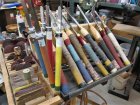
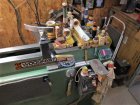
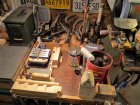
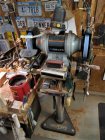
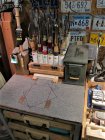
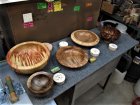
1. Main tool rack
2. On board tool caddy
3. Tool rests
4. Delta slow grinder, and accessories
5. Secondary tool rack
6. Bowls currently in progress
L to R:
Red box elder
English Walnut
Fiddleback Maple
Maple Burl
Australian White Tob Burl
East India Rosewood
-----odie-----






1. Main tool rack
2. On board tool caddy
3. Tool rests
4. Delta slow grinder, and accessories
5. Secondary tool rack
6. Bowls currently in progress
L to R:
Red box elder
English Walnut
Fiddleback Maple
Maple Burl
Australian White Tob Burl
East India Rosewood
-----odie-----
What's that carpet and jig for on your secondary tool cart?
All of my cutting tools are mounted under the lathe and some on the end, sliding into pvc pipes sharp end 1st All tool handle butt end are labeled as well as like tools co-located. Tool rests and chucks have an anchored spot on a shelf under the angled tools. Drawers underneath all that hold extra jaws and various other tool. The pics are a bit dark but all I have at the moment.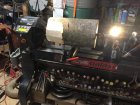
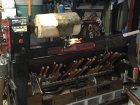


Odie
Panning for Montana gold, with Betsy, the mule!
What's that carpet and jig for on your secondary tool cart?
Sorry Russell.......I hadn't realized you had asked me a question, until just now. The little schematic you see drawn on the rug is part of my method of raising burs on scrapers. This is a more recent addition, but I've been manually raising burs for quite a long time. What you are seeing are the last two steps of a 4-step method of doing this. Raising burs is not very common for woodturners anymore......usually you see mostly woodcarvers doing this now, but it was something that woodturners did use more commonly long ago. This is along the same lines as my insistence on using a traditional grind gouge, while most turners use, or have moved on to the more modern swept back grinds.
-----odie-----
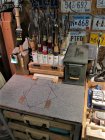
That is an interesting point you have about raising burrs, maybe a new thread should be started to discuss the various uses and methods. The first might be to explain the diagram on the carpet.Sorry Russell.......I hadn't realized you had asked me a question, until just now. The little schematic you see drawn on the rug is part of my method of raising burs on scrapers. This is a more recent addition, but I've been manually raising burs for quite a long time. What you are seeing are the last two steps of a 4-step method of doing this. Raising burs is not very common for woodturners anymore......usually you see mostly woodcarvers doing this now, but it was something that woodturners did use more commonly long ago. This is along the same lines as my insistence on using a traditional grind gouge, while most turners use, or have moved on to the more modern swept back grinds.
-----odie-----
View attachment 29018
Yes Odie an explanation of your burr turning method would be interesting
Odie
Panning for Montana gold, with Betsy, the mule!
That is an interesting point you have about raising burrs, maybe a new thread should be started to discuss the various uses and methods. The first might be to explain the diagram on the carpet.
Yes Odie an explanation of your burr turning method would be interesting
Many woodworkers raise burs by hand holding the scraper, and rubbing the steel (or carbide) by hand on the edge. Some use a Veritas jig permanently mounted by screws. I use the Veritas jig, but it's solidly held between the jaws of a drill press vise, while I raise a bur. I find this to be a much more positive method of uniformly raising a bur. A "ground" bur also works, but the ground burs have a more jagged edge. The diagram is something I came up with so that it doesn't waste my table space when I'm not using it. I used to have a special jig that fit between the ways of the lathe, but that was inconvenient, and got in the way of other things going on with the lathe.
I use the raised bur scrapers in much the same way that others use a ground bur scraper. No difference in how it's used, but with practice, the raised bur is a bit more versatile.
The four steps I use to raise a bur are:
1. grind scraper forward edge on grinder (just like making a "ground bur")
2. Polish the bottom corners of the scraper. (This makes the scraper slide on the tool rest easier while canted for shear scraping)
3. remove ground bur. The veritas jig is removed from the drill press vise, and the scraper is held firmly between the vise jaws. (I'm using a flat diamond hone for this)
4. Raise the bur on the Veritas jig. (held solidly in the vise jaws, and using my hips to apply force)
-----odie-----
The veritas is now mounted on a drill press vise, and the outlines you see on the previous photo represent the positioning of the vise while I perform the last two steps of raising the bur:
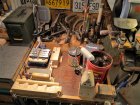
Attachments
Last edited:
- Joined
- Feb 6, 2010
- Messages
- 3,421
- Likes
- 2,503
- Location
- Brandon, MS
- Website
- threeringswoodshop.square.site
lathe.
I use the raised bur scrapers in much the same way that others use a ground bur scraper. No difference in how it's used, but with practice, the raised bur is a bit more versatile.
The four steps I use to raise a bur are:
1. grind scraper forward edge on grinder (just like making a "ground bur")
2. Polish the bottom corners of the scraper. (This makes the scraper slide on the tool rest easier while canted for shear scraping)
3. remove ground bur. The veritas jig is removed from the drill press vise, and the scraper is held firmly between the vise jaws. (I'm using a flat diamond hone for this)
4. Raise the bur on the Veritas jig. (held solidly in the vise jaws, and using my hips to apply force)
-----odie-----
The veritas is now mounted on a drill press vise, and the outlines you see on the previous photo represent the positioning of the vise while I perform the last two steps of raising the bur:
View attachment 29020
To add to Odies post on scrapers this link will give you a better and more comprehensive look at sharpening cabinet scrapers. Also using a stone to flatten the scraper will give a smoother edge.
http://www.timberframe-tools.com/tools/sharpening-card-scraper/
in addition there are many posts on this subject but the difference these methods are just getting more refined.

